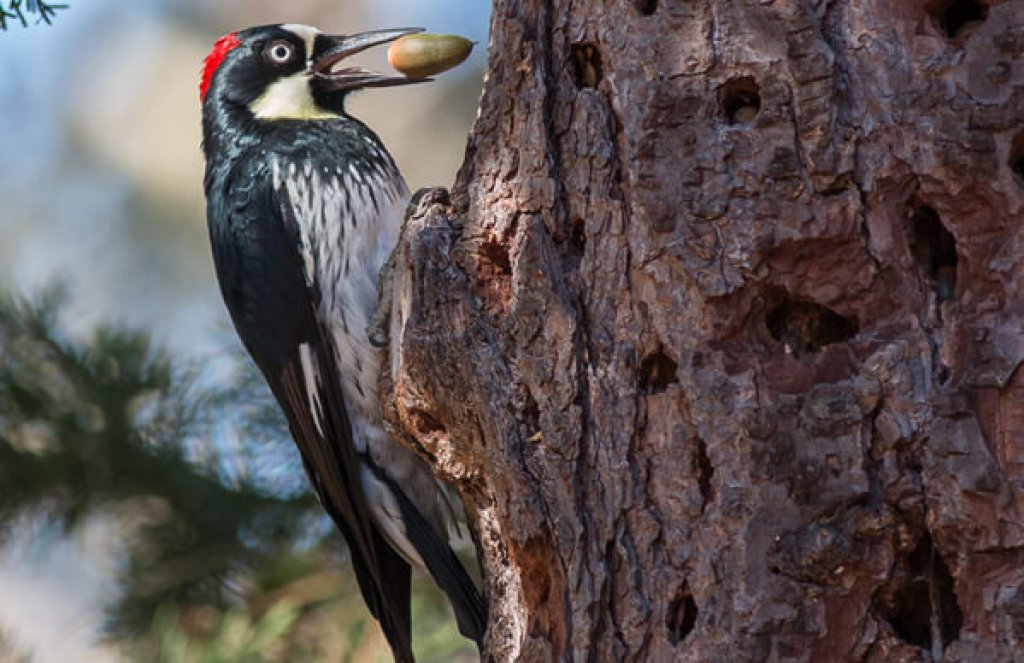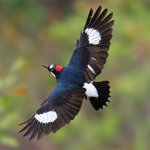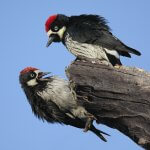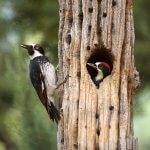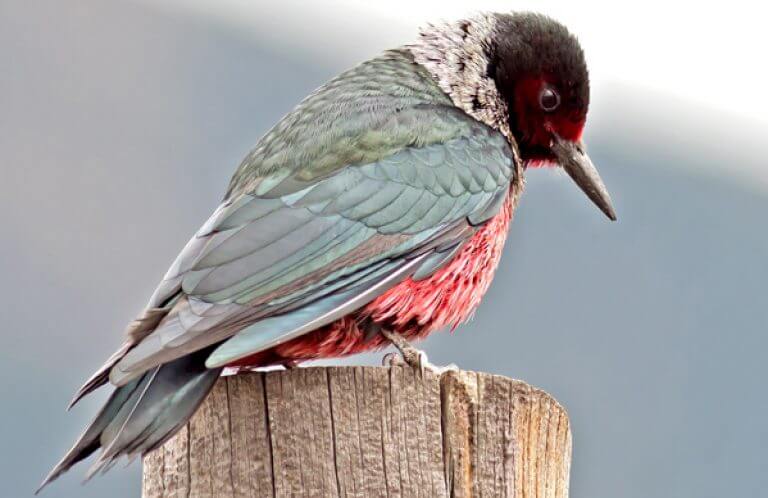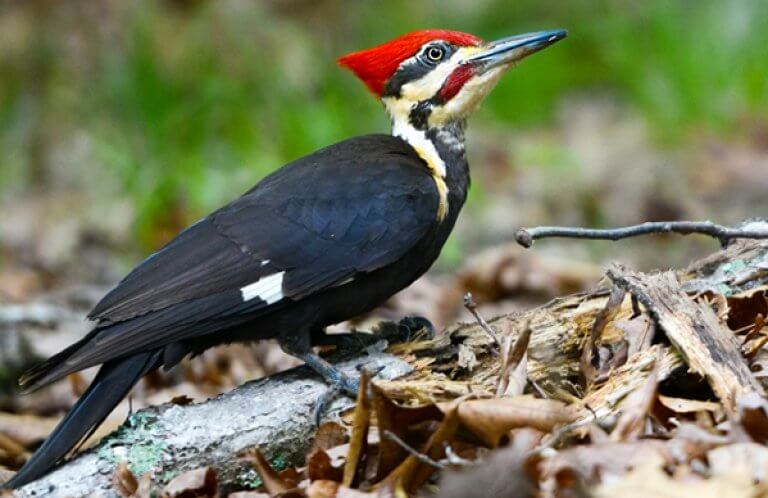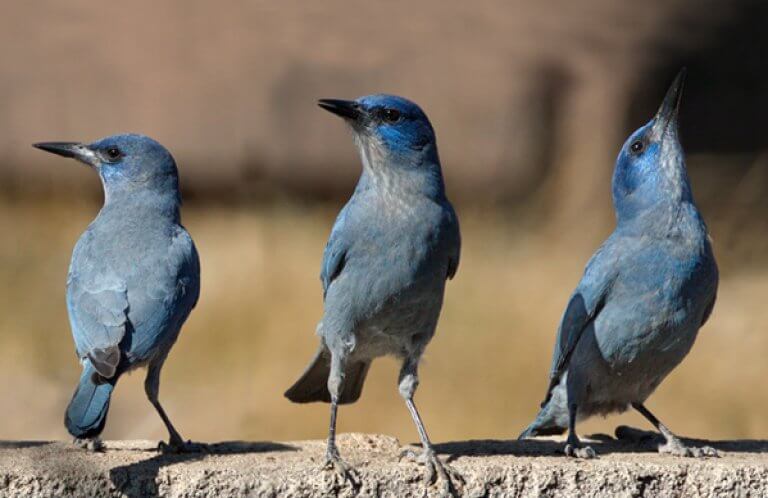About the Acorn Woodpecker
The eye-catching Acorn Woodpecker's head is boldly patterned in black, white, and red, punctuated with wild-looking white eyes that give it a clownish look. It's a medium-sized bird, bigger than a Downy Woodpecker and a bit smaller than its close, but more easterly, relative the Red-headed Woodpecker.
A Bushel of Birds
A group of Acorn Woodpeckers is known as a "bushel" — a perfect description for this bird's unusual habit of squirreling away large quantities of acorns in granaries or "acorn trees." Some of these granary trees have up to 50,000 holes — drilled, stocked, and maintained by extended Acorn Woodpecker families.
Granary maintenance takes up a significant amount of this woodpecker's time, as acorn stocks need to be constantly turned and moved to different holes as they dry and shrink. Since the acorns are visible, the Acorn Woodpeckers also must defend their larder against potential cache-robbers such as Steller's Jays, White-breasted Nuthatches, and Spotted Towhees.
In some parts of its range, the Acorn Woodpecker does not create a "granary tree," but instead stores acorns in natural holes and cracks in bark. Sometimes these woodpeckers choose more unusual storage spots: One Arizona landowner discovered that these industrious birds had stashed 485 pounds of acorns in his wooden water tank!
Why do Acorn Woodpeckers take such drastic measures to store food? This caching is actually an effective strategy for surviving the winter, allowing the birds to skip the perils of migration and stay on the same territory year-round.
Songs and Sounds
One of the Acorn Woodpecker's most commonly heard calls is a loud, repeated waka-waka. The popular cartoon character Woody Woodpecker was inspired by a noisy Acorn Woodpecker that disrupted animator Walter Lantz's honeymoon by persistently calling and drumming on the couple's cabin. (That said, a case can be made that Woody sounds more like a Pileated Woodpecker; visit that page and see what you think.)
Audio of Acorn Woodpecker by Paul Marvin, XC546788. Accessible at www.xeno-canto.org/546788.
Breeding and Feeding
Parental Perils and Communal Concerns
Like the Pinyon Jay, another social, nut-loving bird, the Acorn Woodpecker lives, breeds, and nests in groups. Colonies have one to three breeding females and up to eight breeding males, as well as young birds from previous broods. This communal lifestyle precludes the necessity of courtship and pair-bonding displays, as adult males mate with any or all of the group's female breeders.
The colony works together to excavate a nest cavity in a dead or living branch of a large tree, or in a dead tree. The nest cavity is sometimes located in the granary tree, and the group may use the same nest cavity for several seasons. (Each territory contains other cavities used as nightly roosting sites.)
If more than one female in a colony breeds, they lay eggs in the same nest cavity. When egg-laying is not synchronized, females often destroy each other's eggs. In-synch egg-layers, however, produce a clutch totaling three to seven eggs. Although this behavior seems counterproductive, it may be beneficial, resulting in all chicks being roughly the same age and size. Coming a little late to the party has benefits in this case: A female laying the final clutch may wind up having more of her eggs incubated.
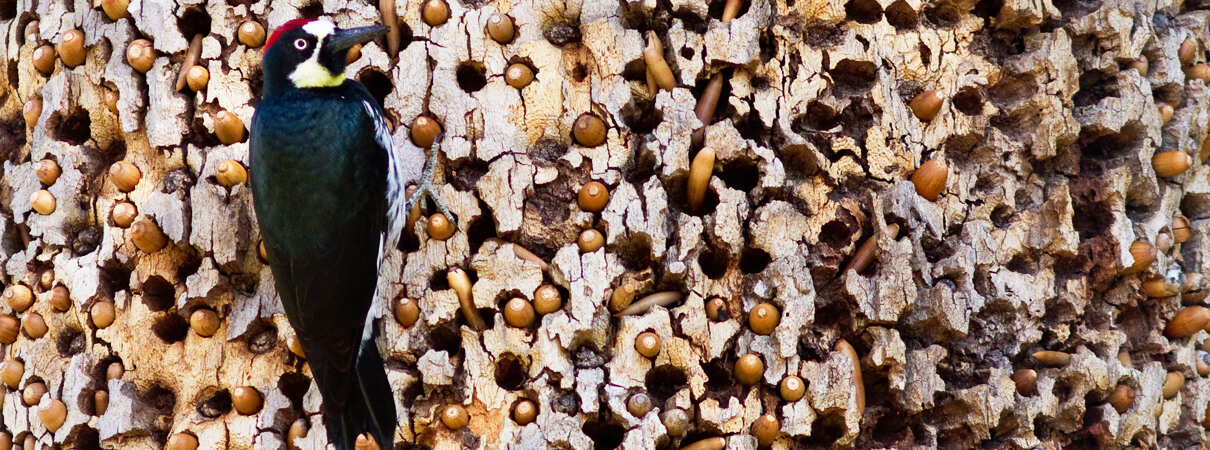
All members of the colony share in incubation duties, and all pitch in to feed the chicks when they hatch. Young adults remain with their parents for several years to help raise successive broods, but eventually they disperse to other territories.
This kind of cooperative breeding system is rare, occurring in only 9 percent of bird species. Researchers believe that this arrangement works well for species with limited suitable habitat, or food resources that fluctuate in availability from year to year — conditions that also favor having a well-stocked acorn granary nearby.
As their name implies, Acorn Woodpeckers rely heavily upon acorns for food. In fact, they rarely stray far from oaks and do best in areas with various oak species, which allows the birds to increase their chances both to take advantage of good crop years and survive crop failures. Acorn Woodpeckers also consume insects, sap, and fruit, and occasionally eat grass seeds, lizards, and bird eggs. Sometimes they hawk for insects in the manner of the Red-headed Woodpecker or Lewis's Woodpecker, another close relative.
Region and Range

The Acorn Woodpecker is a permanent resident throughout the Americas, found from southern Washington state, south through California, and east to Colorado, New Mexico, and western Texas. Populations also occur in oak forests in Mexican mountain ranges, south through Central American highlands, to the northern Andes of Colombia. Seven Acorn Woodpecker subspecies are recognized, based on small variations in plumage color and pattern.
Conservation of the Acorn Woodpecker
Needing Oaks, No Joke
Like the Pileated Woodpecker, the Acorn Woodpecker adapts well to human modifications to the landscape, sometimes using manmade structures for roosting and food-caching. However, this clown-faced bird's dependence on acorns means that it needs mature oak forests nearby to provide food and nest sites, so habitat loss is an ever-present threat. Other threats to the Acorn Woodpecker include competition for nest holes from introduced European Starlings and loss of oak habitat due to disease and climate change.
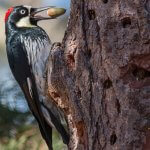
Help support ABC's conservation mission!
ABC's past involvement with the Quercus and Aves program has benefited the Acorn Woodpecker across its range. This program protects and enhances oak habitats across the Americas, and has sponsored educational and outreach efforts including workshops, presentations, and printed materials.
ABC is also working with partners like the Greenbelt Land Trust to protect and enhance oak savanna and grassland in western Oregon's Willamette Valley, an important region for the Acorn Woodpecker and rare and declining birds such as the Oregon Vesper Sparrow and Streaked Horned Lark.
Get Involved
Policies enacted by the U.S. Congress and federal agencies, such as the U.S. Fish and Wildlife Service, have a huge impact on America's birds. You can help shape these rules for the better by telling lawmakers to prioritize birds, bird habitat, and bird-friendly measures. To get started, visit ABC's Action Center.
Living a bird-friendly life can have an immediate impact on the birds around you. Doing so can be as easy as adding native plants to your garden, avoiding pesticides, and keeping cats indoors. To learn more, visit our Bird-Friendly Life page.
American Bird Conservancy and our Migratory Bird Joint Venture partners have improved conservation management on more than 6.4 million acres of U.S. bird habitat — an area larger than the state of Maryland — over the last ten years. This is a monumental undertaking, requiring the support of many, and you can help by making a gift today.





































